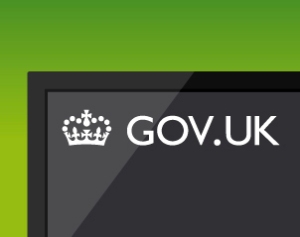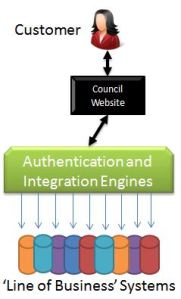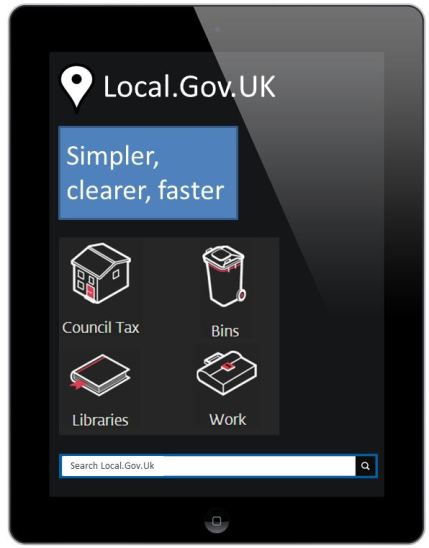140 characters is not a lot of space, but sometimes a tweet can contain a very big idea. In December 2013 Dominic Campbell (@dominiccampbell) tweeted:
“I reckon it would be possible to build a GDS platform for all #localgov for the price of the new Birmingham Library website”
If you’re not sure what GDS is then click here.
GDS certainly seem to have no appetite to attempt to tackle local gov – they have too much on their plate already. They have offered to share code, standards, APIs, frameworks etc – the philosophy being that we create a service of ‘small pieces loosely joined’ (a phrase which was originally used as an analogy to describe the Internet) – this means that responsibility for implementing this stuff would be devolved to individual Councils. It’s nice of the GDS to offer to share this knowledge, but I don’t think it’s quite the right approach – we’re already a community of small pieces, loosely joined and we’re in a mess, we’re fragmented.  Rather than being handed a set of tools and the message – “This is how we did it for Central Gov – knock yourself out!” – I would like to see the creation of a Local Government Digital Service which oversees the standardisation and improvement of all things digital in Councils. For the purpose of this discussion I’m defining a Local Government Digital Service as simultaneously being a philosophy, an IT strategy and a central team of people capable of delivering it.
Rather than being handed a set of tools and the message – “This is how we did it for Central Gov – knock yourself out!” – I would like to see the creation of a Local Government Digital Service which oversees the standardisation and improvement of all things digital in Councils. For the purpose of this discussion I’m defining a Local Government Digital Service as simultaneously being a philosophy, an IT strategy and a central team of people capable of delivering it.
So what problems would a Local Government Digital Service solve, what would the service look like and how hard would it be to create it?

What problems would Local GDS solve?
This bit’s easy – there are 326 Local Authorities (LAs)/Councils in England (http://en.wikipedia.org/wiki/Districts_of_England).
That’s 326 organisation doing, pretty much, the same thing. In terms of IT this means 326 websites, 326 email systems, 326 social care systems, 326 planning systems, 326 education systems etc etc.
This is not quite true as not all LAs have, for example, responsibility as a LEA – but you get the idea.
I estimate that an averaged sized Council will be running around 75 different ‘line of business’ applications – by which I mean the ‘serious’ software that’s used to underpin service delivery, I’m excluding client installs such as CAD or pseudo-systems like MS Access databases and spreadsheets.
326 x 75 = 24,250 software applications.
So the first benefit of a Local GDS is obvious – increased efficiency through removal of expensive duplication.

The second benefit is around the user experience. Council websites vary in quality enormously – by implementing a single site which features the beautiful design principles of Gov.uk we can standardise content and quality and thereby vastly improve the user experience. Local.Gov.Uk anyone? (The LGA own the local.gov.uk address at the moment – we’d need to shift them)
OK – so it’s a no-brainer, if we could make Local GDS happen then there are serious benefits to be had. But how do we make it happen?
What would Local GDS look like and how might it be brought about?
Part 1: Serving Out Information from Local.Gov.Uk
Councils don’t need to have a website each – we can replace them all with a central Local.Gov.Uk site. Many visitors to Council sites are looking for information rather than wanting to interact/transact with the Council. The same is true of Gov.Uk. Gov.uk is largely about information dissemination – GDS went through the various departmental websites, binned a lot of dross and then re-presented the important info in an accessible way. This bit is relatively easy to replicate for a Local.Gov.Uk:
- Identify those bits of information which are common across Local Gov.
- Create a Local.Gov.Uk site (same look and feel as Gov.uk) and populate it with the important information.
- Cull the old Council sites which are now obsolete.
- Save a fortune on Content Management Systems and hosting costs.
Clearly we will need to have a site which recognises that not all parts of the country are the same – some Councils have coastline, some have ports, others have zoos, some have motor racing circuits – the list goes on and all these things bring with them policy and service delivery implications which are not standard across all Councils. Furthermore, as already mentioned, not all tiers of Local Gov have the same statutory responsibilities – not all Councils act as the LEA, for example. These things shouldn’t be a barrier to Local.Gov.Uk though – any transaction/search would begin by capturing the citizen’s post code and the resulting information can be tailored accordingly. Imagine how great it would be for the user of the service to not have to care about whether their area is covered by more than one Local Authority, each with different responsibilities. It reflects poorly on us that we expect our customers to concern themselves with this kind of organisational detail.
Part 2: Transactional Services via Local.Gov.Uk
A single national web presence for local services would be a huge achievement, yet it would still be just the first step on a much longer journey. Standardising the information we push out is the easy part – delivering transactional services online is where the big challenge is – but this is also where the big savings can be realised.
 Most Councils have already started implementing some variant of the ‘My Account‘ or ‘Your Account’ service. Often these have the Council’s name appended ‘My Sheffield’ or ‘My Manchester’ and these services will give the citizen some ability to interact with their Council in a way which directly replaces the need to make contact via other channels (telephone and face to face).
Most Councils have already started implementing some variant of the ‘My Account‘ or ‘Your Account’ service. Often these have the Council’s name appended ‘My Sheffield’ or ‘My Manchester’ and these services will give the citizen some ability to interact with their Council in a way which directly replaces the need to make contact via other channels (telephone and face to face).
This is great news – Digital by Default, Channel Shift – excellent – it’s where we need to be and it’s self evidently the right thing to do. But it’s no small task to make a ‘back end line of business system’ accessible to customers – it’s hard to do and costs  a huge amount of money. There are integration tools to buy, APIs to buy, then you have to think about authentication (this is tricky) and finally the Council will create a new website (branded to look like its main site) from which the customer gains access to the back-end data.
a huge amount of money. There are integration tools to buy, APIs to buy, then you have to think about authentication (this is tricky) and finally the Council will create a new website (branded to look like its main site) from which the customer gains access to the back-end data.
Typically it might take a Council 2 years and hundreds of thousands of pounds to get to this point. That’s OK though because as we all know the cost of an online transaction is a fraction of that of its face-to-face counterpart – the investment pays for itself quickly and many times over.
Fine – but ALL the Councils are on this journey – we’re all building identical architecture to do the same thing. We’re all trying to bring about channel shift in isolation.
This is clearly bonkers – but Local.Gov.Uk gives us a way out. We can begin rationalising this model a layer at a time.
First, as already discussed, we remove the need for Councils to host and maintain their own websites. We replace this layer with the elegant simplicity of Local.Gov.Uk:
Next the Local GDS team uses the GDS’ well documented iterative development techniques to write integration with the Council’s back-end systems. This would be done starting with those systems that are most common and/or have the highest volume of transactions. This is not as onerous a task as it might sound – the mission critical systems in Local Gov are shared between just 4 or 5 suppliers. In terms of authentication – we’d also jump on GDS’ ready made identity and authentication tools to crack that (thorny) problem – by the time Local.Gov.Uk goes live nearly all our customers will have registered with Gov.Uk for one service or another.
Once we’ve got to this point it becomes clear that Councils no longer need to procure 326 different instances of each system – why don’t we work together to get bigger, better, cheaper contracts from our suppliers? Delivered as SaaS of course – we don’t need any tin in our data centres:
I’m conscious that I haven’t mentioned the Public Services Network (PSN) in this  discussion yet. PSN would be a key enabler of Local GDS – PSN is the secure network that joins it/us together and, potentially, could be the place where many of the SaaS systems are hosted – in effect PSN would be a secure cloud for Local GDS.
discussion yet. PSN would be a key enabler of Local GDS – PSN is the secure network that joins it/us together and, potentially, could be the place where many of the SaaS systems are hosted – in effect PSN would be a secure cloud for Local GDS.
Next Steps?
I’ve been ‘doing’ digital in Local Government for (too) many years – so I appreciate that all of the above will be hard to bring about. A significant challenge to Local.Gov.Uk/Local GDS will be  convincing all authorities to get on board. In a presentation at the 2013 SOCITM conference (see video at the end of this post) GDS’ Mike Bracken (@MTBracken) said – “It was the devil’s own job to get 24 departments to agree to adopt Gov.uk”. Imagine that challenge scaled up to 326 Councils? Ouch. I pity the shepherd who gets the job of herding those cats.
convincing all authorities to get on board. In a presentation at the 2013 SOCITM conference (see video at the end of this post) GDS’ Mike Bracken (@MTBracken) said – “It was the devil’s own job to get 24 departments to agree to adopt Gov.uk”. Imagine that challenge scaled up to 326 Councils? Ouch. I pity the shepherd who gets the job of herding those cats.
A second major challenge to the Local GDS model is that it threatens the profits of the major software suppliers. The big suppliers – you know who they are – are very happy to sell the same software to 300 customers. Much less attractive is a joined up Local Gov wanting to to buy a small number of shared instances of these applications. The procurement and legal dimensions will be complex – but maybe G-Cloud can help us with this?
A further challenge will be in resourcing Local GDS – but logic tells us that there must be a way to do this by better using existing resources across Local Gov. Let’s assume that each Council has a web team of, say, 4 people – some are bigger many are smaller, but 4 feels about right – that’s roughly 1300 people currently involved in maintaining Council websites.
Add the various IT departments in to this and you’re looking at a standing army of over 20,000 people already employed in local digital services. If we could avail our selves of just 0.1% of this resource (20 people) then we’d be able to create a nascent Local GDS. Or, and this is probably more realistic, if each Council contributed a small amount each year we would have ample funds to make Local GDS a reality.
So, to return to where we started – could we build a GDS platform for all Local Gov for the price of Birmingham’s library website? Well that website cost £1.2m to create and £190k per year to run (http://www.bbc.co.uk/news/uk-england-birmingham-25033651) – this feels like more than we’d need for Local GDS in year 1, but not enough in terms of ongoing costs. If each Council agreed to subscribe to Local GDS and paid just £3,000 per year we’d be able deliver a Local.Gov.Uk platform which would:
- Remove the need for individual Council websites
 .
. - Significantly reduce software support and maintenance costs for a range of systems.
- Allow for headcount reductions in web/digital/IT teams.
- Begin to move away from local data centres.
That’s what we used to call an ‘invest to save’ business case in the olden days.
Who could lead on Local GDS? It’s got to be SOCITM hasn’t it? A ready made team of experts in digital government who know what’s needed to transform Local Gov and who are champing at the bit to get cracking.
 You may say that I’m a dreamer – but I’m not the only one. If we start small, keep it simple and take baby steps we can do it.
You may say that I’m a dreamer – but I’m not the only one. If we start small, keep it simple and take baby steps we can do it.
Here’s Mike Bracken’s presentation at SOCITM 2013, well worth a watch:





